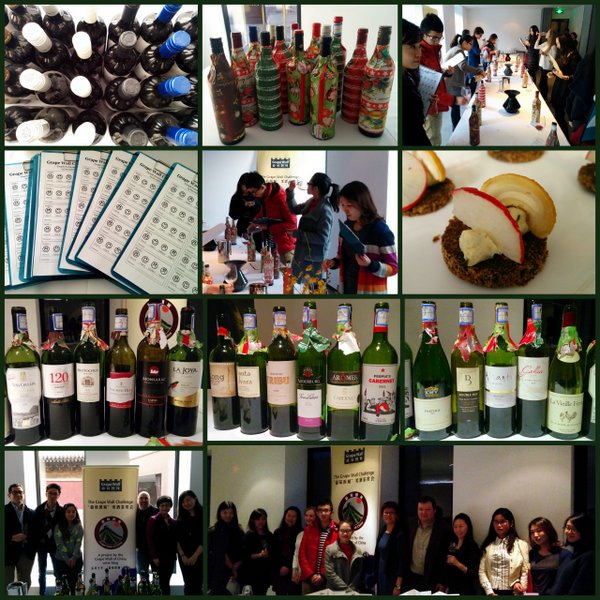
Call it a tribute to consumer power. Every year, we organize a nonprofit event called Grape Wall Challenge (GWC) and ask Chinese consumers to judge wines that retail for under rmb100.
We held the sixth annual Grape Wall Challenge in mid-December at Temple Restaurant Beijing, which kindly provided event space and food. Professor Ma Huiqin of China Agricultural University discussed the wines with the judges after the tasting.
Here are a few common questions about GWC, followed by a list of the winners:
What is the purpose of GWC?
There are two key goals. First, we want to find the best inexpensive wines as decided by consumers. The retail price of most wines sold in China is under rmb100 but writers rarely focus on these.
Second, we want to boost consumer confidence. Many people are intimidated by wine and we want to empower them through involvement in the judging process. Our findings so far? It works!
Also, the ongoing government austerity program has slashed official and state-owned spending on wine. This has shifted the focus to regular consumers and makes GWC even more relevant.
How are the wines judged?
The wines are judged blind. We ask consumers to taste each wine, choose “I love it“, “I like it“, “I dislike it” or “I hate it“, and write a few comments. This year’s comments included, “sweet but soft”, “simply juicy”, “vivid”, “makes people feel young”, “soft like water”, “sugar girl”, “passionate” and “I think I can drink the whole bottle”.
Where do you get the wines?
We asked top importers / distributors to submit up to three wines. We focus on these companies because they distribute widely and that makes it easier for readers to find the wines. We also assume they will send us wines they think consumers like best, thus we get an idea of what the trade thinks is popular.
This year we focused on red wines and covered eight countries – Argentina, Australia, Chile, China, France, Portugal, Spain and South Africa — and more than a dozen grape varieties. The distributors were ASC, China Wines & Spirits, East Meets West, French Wine Paradox, Links Concept, Summergate and Torres.
Which wines scored highest?
To determine the results, we add the “love it” (10 points), “like it” (7 points), “dislike it” (4 points) and “hate it” (1 point) scores for each wine and divide by the number of tasters in order to get an average score. The highest average scores win.
Here are the wines with the five highest scores followed by those with the most ‘Olympics medals’. I included links to the distributors and will update this post soon with more details about which retailers carry these brands.
Top Five Scores
As in previous years, wines from Argentina and South Africa made the top five. It was a “new world” sweep, save for one wine from Spain, as we once again found fruity wines getting the best scores.
1. Trivento ‘Tribu’ Malbec 2013 from Argentina. Distributed by Summergate, available at Pudao Wines, rmb95.
2. Santa Alvara Carménère from Chile. Distributed by French Wine Paradox, rmb81.
3. Bocopa ‘Alcanta’ Merlot 2010 from Spain. Distributed by French Wine Paradox, price rmb65.
4. KWV ‘Classic’ Pinotage 2012 from South Africa. Distributed by China Wines & Spirits, available from CWS, price rmb87.
5. Nederburg ‘Foundation’ Shiraz-Pinotage 2013 from South Africa. Distributed by ASC, price rmb89.
‘Olympic’ Medalists
We also asked each judge to pick a “gold“, “silver” and “bronze” medal winner, in other words, their three favorite wines. In addition to the five wines listed above, the following received at least three medal’:
(7) La Joya ‘Reserve’ Merlot 2013 from Chile. Distributed by Links Concept, available at Jenny Wang, price rmb86.
(5) Callia Malbec-Syrah 2014 from Argentina. Distributed by Torres, available at Everwines, price rmb87.
(4) Long Country Cabernet Sauvignon 2013 from Chile. Distributed by East Meets West, rmb100.
(3) Double Bay Cabernet-Merlot 2012 from Australia. Distributed by Links Concept, available at Jenny Wang, price rmb99.
Again, I will update with more details on where to get these wines.
While time pressure meant this year’s event had to be organized quickly and went less smoothly than last year, it was nevertheless fun to get together with consumers and see what they enjoy.  This remains one of my favorite events to organize and I will have details soon on the 2015 edition of the Grape Wall Challenge.
Here is a list of our previous Grape Wall Challenges:
- Temple, 2013 (results).
- F by Tribute, 2012 (results).
- Modo, 2011 (results).
- Maison Boulud, 2010 (results)
- Maxim’s of Paris, 2009 (results).
Note: I also publish a free China wine e-newsletter, usually every four to six weeks. To get it, sign up with your email address using this form:
Sign up for the Grape Wall newsletter here. Follow Grape Wall on LinkedIn, Instagram, Facebook and Twitter. And see my sibling sites World Marselan Day, World Baijiu Day and Beijing Boyce. Grape Wall has no advertisers, so if you find the content useful, please help cover the costs via PayPal, WeChat or Alipay. Contact Grape Wall via grapewallofchina (at) gmail.com.
Leave a Reply
You must be logged in to post a comment.